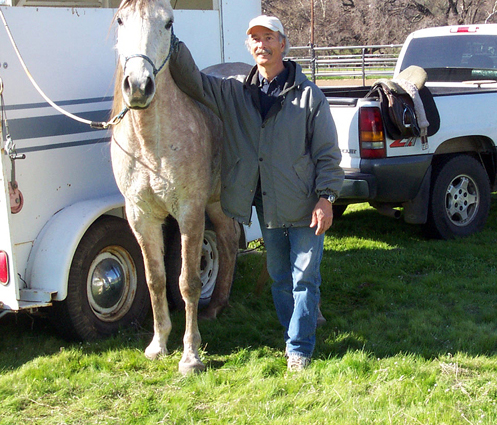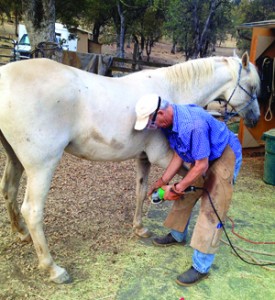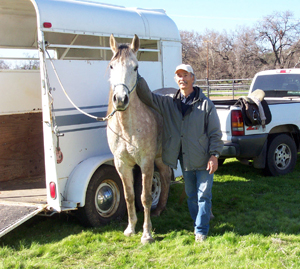
To shoe or not to shoe, that is the question.
By Phil Morarre
This question has been of increasing interest within the equine world in the past ten or twelve years. After much study on this subject the answer seems to be without a doubt not to shoe. Of course there’s more to it then just pulling the shoes. What has evolved over the past decade is now being referred to as the “barefoot movement”. It dictates an entirely new way to trim hooves so that they can function better than ever and without shoes.

What do I base these statements on? Well, let me give you a little background on myself. I have been working with horses in one way or another for over 45 years. In 1991 I discovered natural horsemanship methods and found them to be far superior to the conventional way of riding and training. In 1998 one of my training clients directed me to the website www.barefoothorse.com . That was the beginning of a total transition of thinking in terms of horse’s feet and especially their shoes. The emphasis of this new thinking was on the way the feral mustang’s feet looked and functioned and how horse shoes as well as conventional trimming parameters interfere with the natural functions of the hoof. This concept seemed to make sense to me so I looked into it further and the more I looked the more it made sense.
The discovery of natural hoof care proved to be as enlightening as that of natural horsemanship. Here was a whole new way of treating horse’s feet that led to a tremendous improvement not only in their feet but in their performance and overall health as well. In seeking verification of my understanding in regard to this new concept I made contact with several teachers, though at that time they were few and far between. Still I managed to learn the basics and found it wasn’t really all that hard, but it was quite different from what the farriers I knew were doing.
Soon I was finding myself pretty busy trimming horses for my training clients and friends but still felt the need to learn more, especially in those dark areas involving laminitis/founder & navicular syndrome. It was at this time that I began to attend several advanced clinics presented by Martha Olivo another well known name at the time in the relatively new natural trim movement. The many hoof dissections in those classes gave me a very clear idea of how the hoof functions and why conventional methods were not really working to the best advantage for the horses.

After that I began teaching what I knew at my own clinics and in private lessons. I still continue to learn to this day from the best teachers of all, the horses.
I am currently trimming about 50 horses per month (down from 120) and have been able to observe the positive changes in all of them, this includes 12 horses that were designated to be put down due to severe founder/laminitis and 3 that were diagnosed as incurable navicular horses.
By the Fall or 2005 my body began feeling the strain of using the traditional hoof knife, rasp and nippers. Consequently I began to experiment with several different small power tools such as the Dremel rotary tool. I happened across a post on the internet by Bob Creel a trimmer in Georgia who suggested the idea of using an angle grinder fitted with an abrasive sanding disk. So I decided to give this idea a try. However the angle grinders available all seemed to be quite large and a bit too heavy for extended use with one hand and of course the other hand was needed to hold the foot in place. Still it was better than the hand tools and surprisingly it produced a nicer trim in less time. So I began my search for a lighter, smaller version. This proved to be harder than I thought! It took over a year of testing out many different samples from various factories to finally settle on one that I felt anyone could use comfortably. There was only a slight modification I needed to make myself and that’s how the Softouch Power Hoof Trimmer came into existence. Giving virtually anyone the opportunity to trim their horse the easy way!
Now I must admit my initial thought about using such a tool was “What horse is going to let me get close enough to do anything?” To my surprise on my first attempt with all three of my own horses there was virtually no reaction. They in fact seemed to enjoy the vibrating feeling of the grinder. I have since experienced this same reaction in the hundreds of horses I have introduced this method to with my local clients as well as at my clinics around the country. And now several hundred horse owners and professional trimmers alike have confirmed the same reaction. This method has proven to be a true revolution in the hoof trimming world as more and more trimmers realize the advantages. But as with any revolution there has been a certain amount of resistance from the staunch traditionalists who are simply opposed to change of any kind. None the less it has allowed many people, women in particular, to be able to trim their own horse’s feet which they would have found extremely difficult if not impossible using conventional tools. Many have even gone on to start trimming other peoples horses and several I know personally have gone on to establish very lucrative careers.

If you are new to the idea of doing your own hoof trimming I have made a very detailed instructional DVD to get you started. It has received rave reviews as has the hoof trimming kit I offer as an option to go with the Softouch Trimmer.
See: Softouch Power Trimmer Review by Sullivan Farm
I also now offer a mentorship program for those interested in learning more about this type of trimming but feel they need a one on one experience first. This can be anywhere from one to five days of traveling with me as I trim my clients horses. I also offer private lessons for those who are unable to make it to a clinic.
You can find the essential tools for this method of trimming as well as the DVD on the tools page at: www.softouchnaturalhorsecare.com



